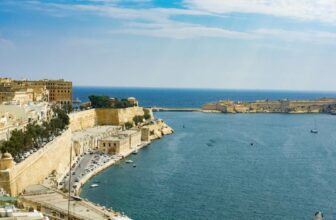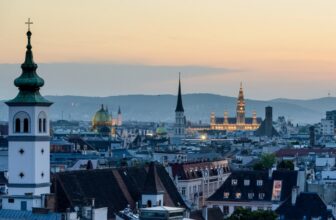Where are the best places to visit in the south of France? Pretty much everywhere.
Few places in Europe provide a better vacation experience than France’s breathtakingly beautiful south. A holiday in this sunny region is a feast for all the senses, from the warmth of its sun-kissed beaches to the perfume of its mouthwatering cuisine.
Here, you get to enjoy the scenery that influenced artists ranging from Renoir and Van Gogh to Matisse and Cézanne.
In southern France, you can experience it all. You can attend a concert at a former Roman amphitheater and dine luxuriously at a restaurant with a Michelin star. A first-rate transit system ensures easy access to every French fairytale town, old fortress, and top-notch museum.
The sights of Southern France will follow you wherever you go, so be sure to add it to your list for your European tour.
5 Breathtaking Places in Southern France
France is a country rich in natural beauty and architectural splendor, with gems like Nice, Cannes, and Avignon.
Along the Promenade des Anglais, Nice combines old-world elegance with lively modernity, captivating visitors with its pebble beaches and turquoise waters. Cannes charms visitors with its opulent yachts and golden sands – causing a cinematic allure. No wonder it’s home to one of the world’s most famous film festivals.
The Papal Palace and the Pont Saint-Bénézet, which connect history and art, give Avignon, surrounded by medieval apartments, a timeless beauty. Each area, distinct in its compassion, represents the essence of France — its people, culture, cuisine, and alluring landscapes that never cease to enchant the world.
Nice
Nice has everything vacationers seek from a French Riviera vacation, from world-class art and medieval architecture to breathtaking beaches. It’s located in southeast France and has a number of pedestrian-friendly attractions, like seaside promenades, magnificent plazas, and open-air markets.
In Vieux Nice, which has an Italianate style, you can study the city’s past while eating specialties ranging from pastries to pizzas at the neighborhood’s cafés. To learn about the culture, stop at the Musée Marc Chagall and Musée Matisse. These two museums house hundreds of pieces by these two French artists.
Marvel at the Eye-Popping Artworks of the Musée Matisse
This museum is housed within the 17th-era Mansion des Arènes, a lovely Genoese-style structure, and includes one of the nation’s largest collections of Henri Matisse’s works.
He lived in Nice until his death in November 1954 because the town had a great effect on his creative approach. At the gallery, you’ll see an amazing collection of his paintings as well as publications.
Avignon
Avignon is most renowned for the Palais des Papes, Europe’s largest Gothic palace. The fortified castle sits at the bottom of a hill overlooking the Rhône River and was built in the 14th century as an act of defiance against Pope Clement V’s election. Inside the chair of the Papacy are jewels, such as a set of paintings painted in the 1300s by Matteo Giovannetti.
The palace also hosts art exhibitions, conventions, and festivals. Outside, hilltop gardens, ponds, and groomed terraces beckon. The Musée Angladon, which has the only Van Gogh artwork in Provence, is also well worth a visit.
Check Out Palais des Papes
The size of the 14th-century Papal Palace cannot be appreciated until you see it in person. To give you an idea, you could fit four Gothic cathedrals inside, and there are 24 rooms to visit on the tour.
It’s the main attraction of Avignon’s UNESCO World Heritage site, as well as one of France’s most famous and precious historical structures.
The palace is open every day from 9 am until 7 pm. You should plan 3 hours for a visit and get there early because it can get extremely busy.
Cannes
Cannes has been synonymous with movies, so put on your best heels and walk along the iconic Boulevard de la Croisette. This lane connects retailers like Chanel to the ocean, as well as high-end restaurants and hotels. Bâoli Beach, Cannes, is the place to be for day-to-night festivities.
At midnight, the restaurant changes into a raucous nightclub, complete with sparkler-filled magnums. Its sibling location, on the far end of the Croisette in Port Pierre Canto, holds some of the film festival’s biggest events.
Go on a Cultural Tour
If you want a feel of what life was like 400 years ago, take a stroll around the streets that line the hill of Le Suquet, the Old Town. Get on a ferry from the Old Port to the Lérins Islands, where you’ll find beautiful beaches and wine made by Cistercian monks, the islands’ only occupants.
Île Sainte-Marguerite is the largest and closest island to mainland Cannes and has historical attractions such as The Man in the Iron Mask‘s cell. Add the upscale beachside restaurant La Guérite to the mix, and a roundtrip ferry ride is a no-brainer.
Antibes
Antibes, located on the coast between Nice and Cannes, began as a Greek colony in the 5th century. The town turned into the opulent vacation destination it is now in the mid-1800s. Walk around the intact rampart walls and into the castle, which houses one of the Old Town’s biggest attractions, the Picasso Museum, to see relics of its fortress history.
After, grab a baguette from one of Antibes’ most famous boulangeries, the three-generation-owned Le Pain JPV. Skip beach day in favor of a picnic lunch along the water on the villa-lined peninsula of Cap d’Antibes.
Visit Hôtel Belles Rives
Are you a fan of literature? Hôtel Belles Rives, a 40-room palace on the seawall in adjacent Juan-les-Pins that houses La Passagère, one of the town’s best diners. It is also where F. Scott Fitzgerald stayed during the 1920s.
While Fitzgerald was inspired by the villa in Tender Is the Night, the Hôtel du Cap-Eden-Roc, it was also immortalized in the work of another artist — photographer Slim Aarons. Spend your evenings drinking bubbly at the rooftop Champagne Lounge, which works solely with 14 top champagne houses. Alternatively, you could sway to the strains of piano at the cave-like Absinthe Bar in the Old Town.
Aix-en-Provence
Visit Aix-en-Provence to appreciate the true southern France way of life. With its bustling outside cafés, open-air areas, and great fountains that grace the main circles, this charming town perfectly captures the essence of the Provençal place.
Like in other Provence towns, the environment is laid-back and quiet. People there have mastered the art of living well, enjoying relaxed lunches and strolls along beautiful, tree-lined streets. The town is full of historic sites, museums, churches, and monuments. Plus, you can explore the local markets and sample some of the delicious regional cuisine.
Wander Around Aix-en-Provence
Explore Quartier Mazarin, an area of the city dating back to the 17th century, where you can wander the streets, admiring the baroque architecture and lush gardens. The Cours Mirabeau is a tree-lined road full of shops and cafes, and Vieil Aix is the old part of town, with cobblestone streets and charming squares.
You can also visit the Atelier de Cézanne and view the works of the famous Post-Impressionist painter. There are also plenty of museums, galleries, and parks to explore and enjoy.
If you’re looking for a stress-free experience, consider this Aix Village and Luberon market tour.
FAQs About the Best Places in Southern France
Here are some of the most asked questions about the South of France.
Is the South of France Worth Visiting?
The South of France is extremely popular with tourists and with good reason. This part of the country has something for everyone, whether you want to visit some of the world’s best wineries or discover old villages.
You can also visit glamorous coastal resorts where you can enjoy fine food and relax on the beach.
When Should I Visit South France?
The best time to visit France is between May and October when the days are long, bright, and sunny. This is the ideal time to appreciate the region’s most famous features: azure coastlines, medieval villages, and rustic beach shacks.
Which Side of France is Better?
France is beautiful on all sides. If you want to really experience this magnificent country, you should include both on your schedule. This isn’t too difficult because they’re now connected by well-maintained highways and high-speed railways.
If you can only choose one, the south is best for beaches and relaxation, skiing, and honeymoons. In contrast, the north is best for history, city breaks, and off-the-beaten-path exploration.
Is the South of France Affordable?
Southern France is fairly pricey, but there are ways to keep costs down. To save money, buy local bread, cheese, and fresh produce from bakeries and markets. Use anything you purchase to cook your meals at your lodging or to eat al fresco on the beach.
Do research on museums, parks, and other public attractions in the city you want to visit. You’ll find that many of the museums have free admission days or periods, so take advantage of those.
Final Thoughts on the Best Places in South France
The allure of the South of France is unmatched, offering a vibrant tapestry of history, culture, and natural beauty and the best French day tours. From the elegance of Nice’s beaches to the cinematic charm of Cannes and the timeless grace of Avignon, this region captivates every sense.
Embrace the rich heritage and picturesque landscapes that have inspired artists throughout history. For an unforgettable European tour, venture through these gems. With a blend of iconic attractions and hidden treasures, the South of France promises an enriching journey that lingers in your heart and memories.











